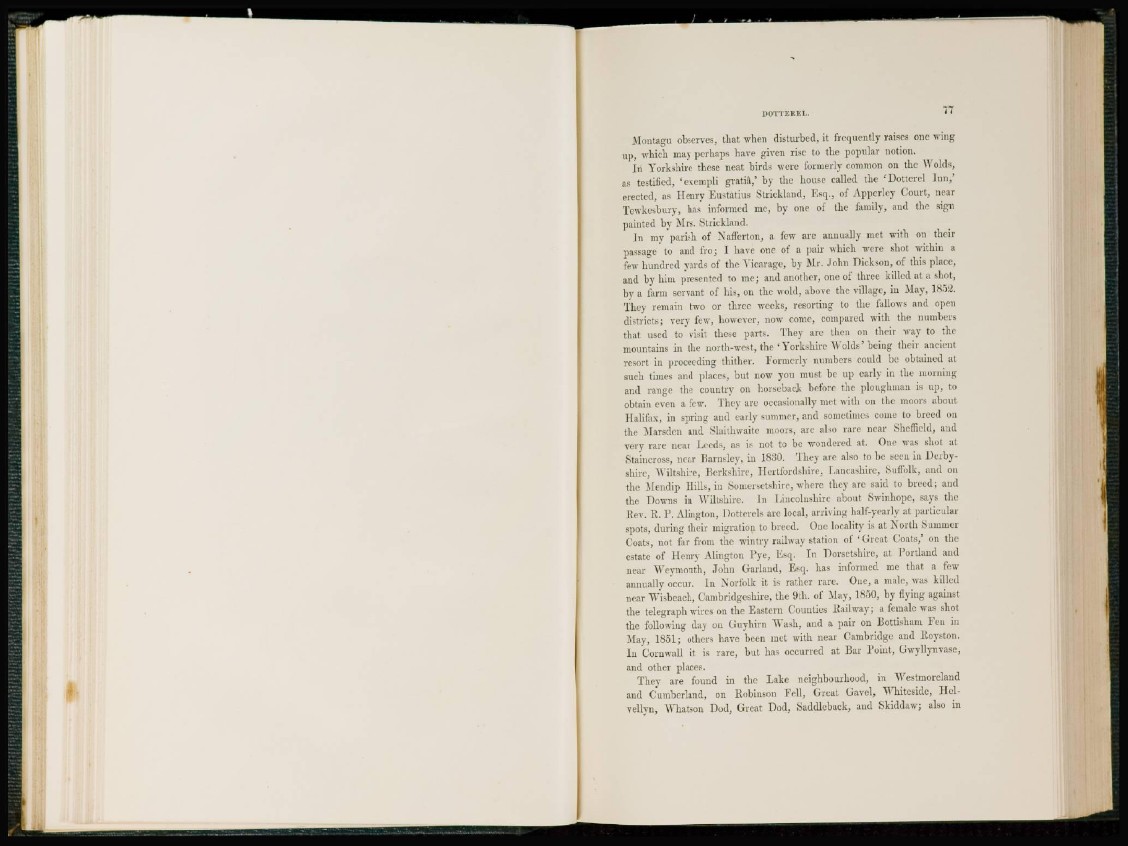
DOTTEREL. 77
Montagu observes, that when disturbed, it frequently raises one wing
up, which may perhaps have given rise to the popular notion.
In Yorkshire these neat birds were formerly common on the Wolds,
as testified, 'exempli gratia,' by the house called the 'Dotterel Inn,'
erected, as Henry Eustatfus Strickland, Esq., of Apperlcy Court, near
Tewkesbury, has informed me, by one of the family, and the sign
painted by Mrs. Strickland.
In my parish of Nafferton, a few are annually met with on their
passage to and fro; I have one of a pair which were shot within a
few hundred yards of the Vicarage, by Mr. John Dickson, of this place,
and by him presented to me; and another, one of three killed at a shot,
by a farm servant of his, on the wold, above the village, in May, 1852.
They remain two or three weeks, resorting to the fallows and open
districts; very few, however, now come, compared with the numbers
that used to visit these parts. They are then on their way to the
mountains in the north-west, the ' Yorkshire Wolds' being their ancient
resort in proceeding thither. Formerly numbers could be obtained at
such times and places, but now you must be up early in the morning
and range the country on horseback before the ploughman is up, to
obtain even a few. They arc occasionally met with on the moors about
Halifax, in spring and early summer, and sometimes come to breed on
the Marsdcn and Slaithwaite moors, are also rare near Sheffield, and
very rare near Leeds, as is not to be wondered at. One was shot at
Staincross, near Bamsley, in 1830. They are also to be seen in Derbyshire,
Wiltshire, Berkshire, Hertfordshire, Lancashire, Suffolk, and on
the Mendip Hills, in Somersetshire, where they arc said to breed; and
the Downs in Wiltshire. In Lincolnshire about Swinhope, says the
Rev. R. 1*. Alington, Dotterels are local, arriving half-yearly at particular
spots, during their migration to breed. One locality is at North Summer
Coats, not far from the wintry railway station o f ' G r e a t Coats/ on the
estate of Henry Alington Pye, Esq. In Dorsetshire, at Portland and
near Weymouth, John Garland, Esq. has informed me that a few
annually occur. In Norfolk it is rather rare. One, a male, was killed
near Wisbeach, Cambridgeshire, the 9ih, of May, 1850, by flying against
the telegraph wires on the Eastern Counties Railway; a female was shot
the following day on Guyhirn Wash, and a pair on Bottisham Feu in
May, 1851; others have been met with near Cambridge and Royston.
In Cornwall it is rare, but has occurred at Bar Point, Gwyllynvase,
and other places.
They are found in the Lake neighbourhood, in Westmoreland
and Cumberland, on Robinson Fell, Great Gavel, Whiteside, Hclvellyn,
Whatson Dod, Great Dod, Saddleback, and Skiddaw; also in